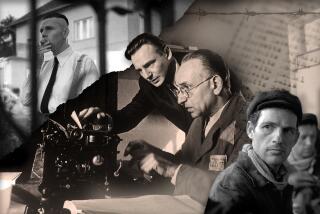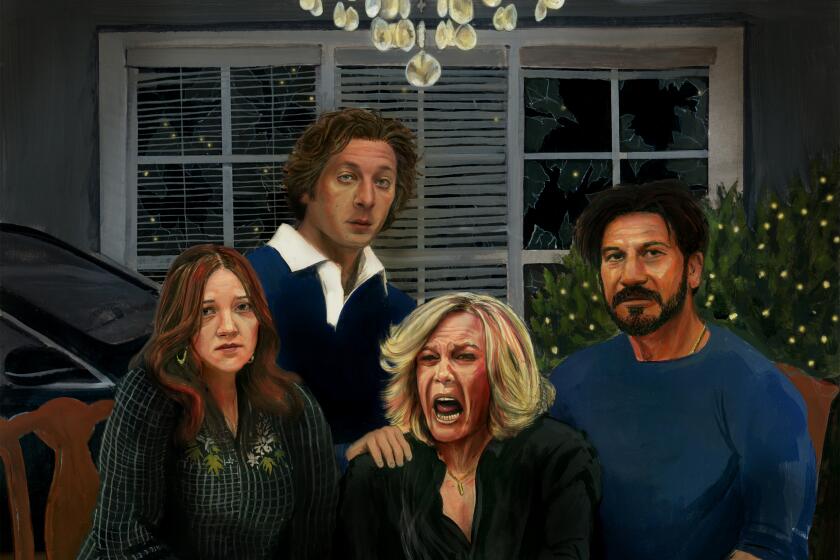The Envelope: Angelina Jolie relies on ‘sweat equity’ in making ‘Unbroken’
Angelina Jolie had directed only one film before she decided to adapt Laura Hillenbrand’s “Unbroken: A World War II Story of Survival, Resilience, and Redemption.” Jolie’s retelling of the heroic tale of Louis Zamperini was a big step up from her first feature, the $10-million, Bosnia-set art house film “In the Land of Blood and Honey” that was released in 2011.
But it wasn’t just the $65-million budget and the historical sweep of “Unbroken” that concerned the actress turned filmmaker (Jolie has since directed herself and husband Brad Pitt in the domestic drama “By the Sea,” which she also wrote).
Jolie said she felt a personal allegiance to Zamperini, who died earlier this year at age 97, and not just because they were Hollywood Hills neighbors. She truly admired the man who survived 47 days on a life raft and endured more than two years of torture in Japanese prisoner of war camps — and still overflowed with compassion and forgiveness.
“I would go out of my way to spend time [with him],” Jolie said recently. “I’d wake up in the morning and all I’d want to do is go over to Louis’ house. I’d rather be with Louie than anybody.”
Why did this story mean so much to you?
It’s something that we need as human beings: to see somebody confronted with so many obstacles in life and refuse to go down and not only stand back up but somehow find a way to love and live again, and be full of usefulness and joy.”
You eliminate the latter chapters in the book, after Zamperini comes home from the war and undergoes a religious conversion. So you tried to hint at the role faith played throughout his life.
It was actually more disrespectful to try to jam that into the last 15 minutes. It actually felt more respectful to say, “These are not sudden themes, and this is not something that’s just an element of his life. This is present from the little teeny boy we see in church all the way through.”
You also decide to show how badly Japanese civilians are suffering during the war.
I know it was important to Louie. You’re so focused on the enemy that when you step back and you see the civilian casualty on both sides, and you understand what is happening, it changes the way you view your enemy. You see something deeper, you see a country, and a people, and mothers and fathers, and it’s not so black and white.
What were your thoughts about how graphically you would depict the torture?
We wanted the movie to be PG-13, which it is, because I have a 13-year-old boy, and whether it be video games or certain kinds of films, they see a lot of horrors. But it’s important to understand the real situations in life, the real history. We wanted it to be true to history that would be hard enough that we were respecting what really happened. Because if you go too light, you’re not paying respect to the reality of history. And if you show too much, you make people turn away and they can’t absorb the information.
How and where do you think you need to grow as a filmmaker?
I’m watching a lot more film, and I’m kind of revisiting the greats and trying to understand and look at the choices they made, and why — to try to understand the language of film from so many different storytellers. It’s a whole new discovery. But I think what’s been interesting for me is not that I have that confidence as a director, but I do have a confidence in believing in the stories that I’ve told. With Louie’s story, I didn’t believe I was technically the best person to do it, but I believed that I cared and I would work day and night. My sweat equity had to mean something. And I was going to try, and I would do my best, and I knew why I was doing it, and I think when you know that inside yourself you know that your intentions are clear and clean, then you have a very direct purpose to pull you through all those other things when you aren’t so sure.
More to Read
From the Oscars to the Emmys.
Get the Envelope newsletter for exclusive awards season coverage, behind-the-scenes stories from the Envelope podcast and columnist Glenn Whipp’s must-read analysis.
You may occasionally receive promotional content from the Los Angeles Times.








